German Human Torpedoes — D-Day’s Nazi Suicide Subs?
July 17th, 2024
9 minute read
Among the Axis partners, Germany was the last to develop the mini-sub concept. When they eventually put a design in the water, it was remarkably simple, while at the same time incredibly dangerous. The Nazi manned torpedoes were some of the Reich’s most wishful thinking, and the insanity of the program led friend and foe alike to dub the weapon a “human torpedo”.
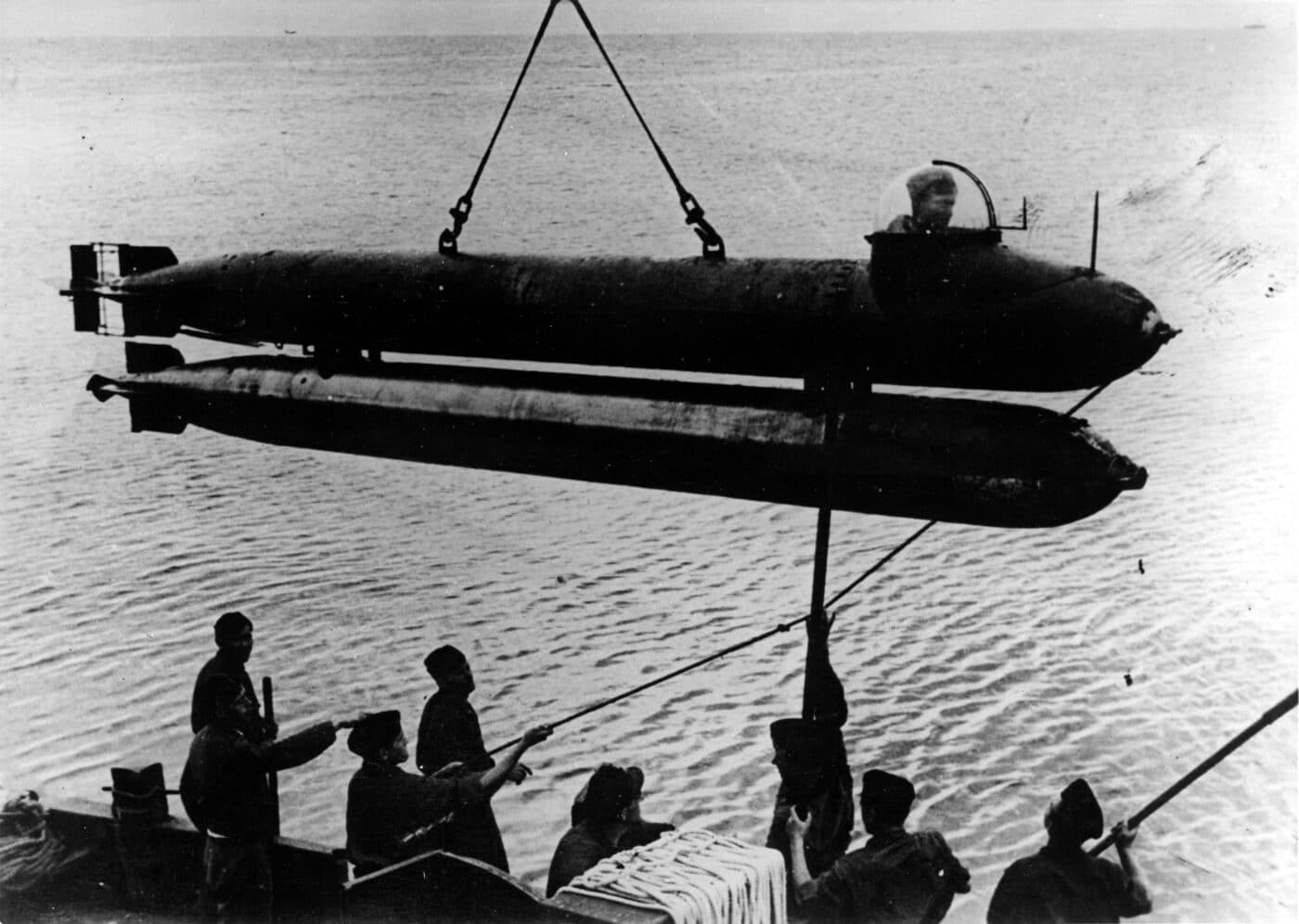
During 1943, with Germany facing Allied invasions in the Mediterranean, and preparing for the eventual invasion that would come across the English Channel, the Kriegsmarine sought to create special attack weapons for their “small battle units”. Naval engineer Richard Mohr was tasked with developing a simple, cost-effective, and easy-to-use weapon that would counter an Allied invasion fleet.
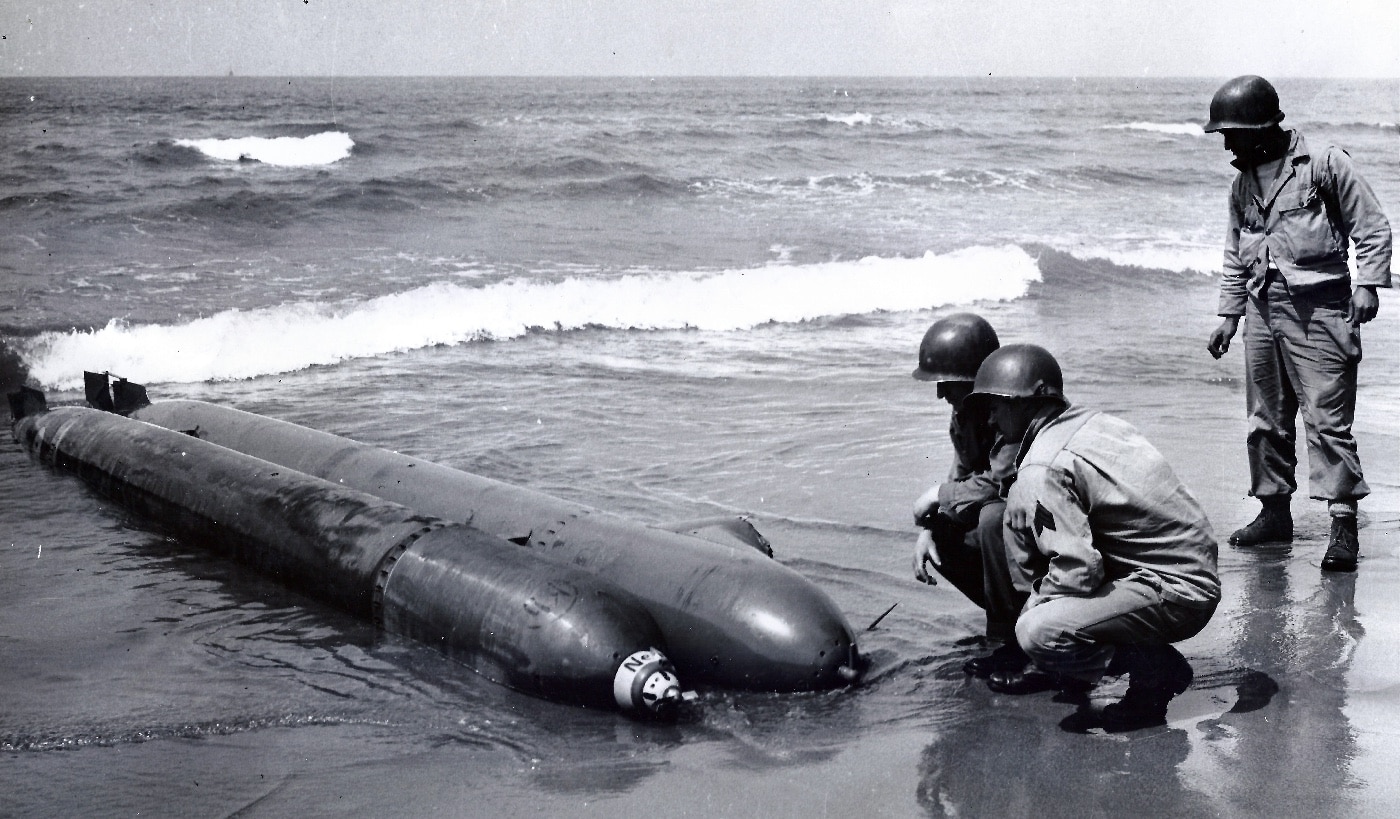
Mohr’s concept used a standard G7e electrically propelled torpedo as the mothership, removing the 1,100-pound warhead (as well as about 50% of the battery capacity) and adding a small, rudimentary cockpit to allow the craft to be operated by a single man. A fully armed G7e torpedo was shackled beneath the manned torpedo to create a short range, one shot, sort of submarine.
Marder Human Torpedo Specifications
- Weight: 2.7 tons
- Size: 7.6 meters x 0.5 meters
- Engine: One 12hp electric motor, single shaft
- Maximum speed: 4 knots
- Range: 48 nautical miles
- One G7e electric torpedo
Initial versions of the system were unable to dive, but the later, slightly larger “Marder” variant could submerge up to 25 meters for a short period of time. The operator himself was the guidance system, carrying a compass on his wrist and wearing a Draeger breathing gear and wet suit.
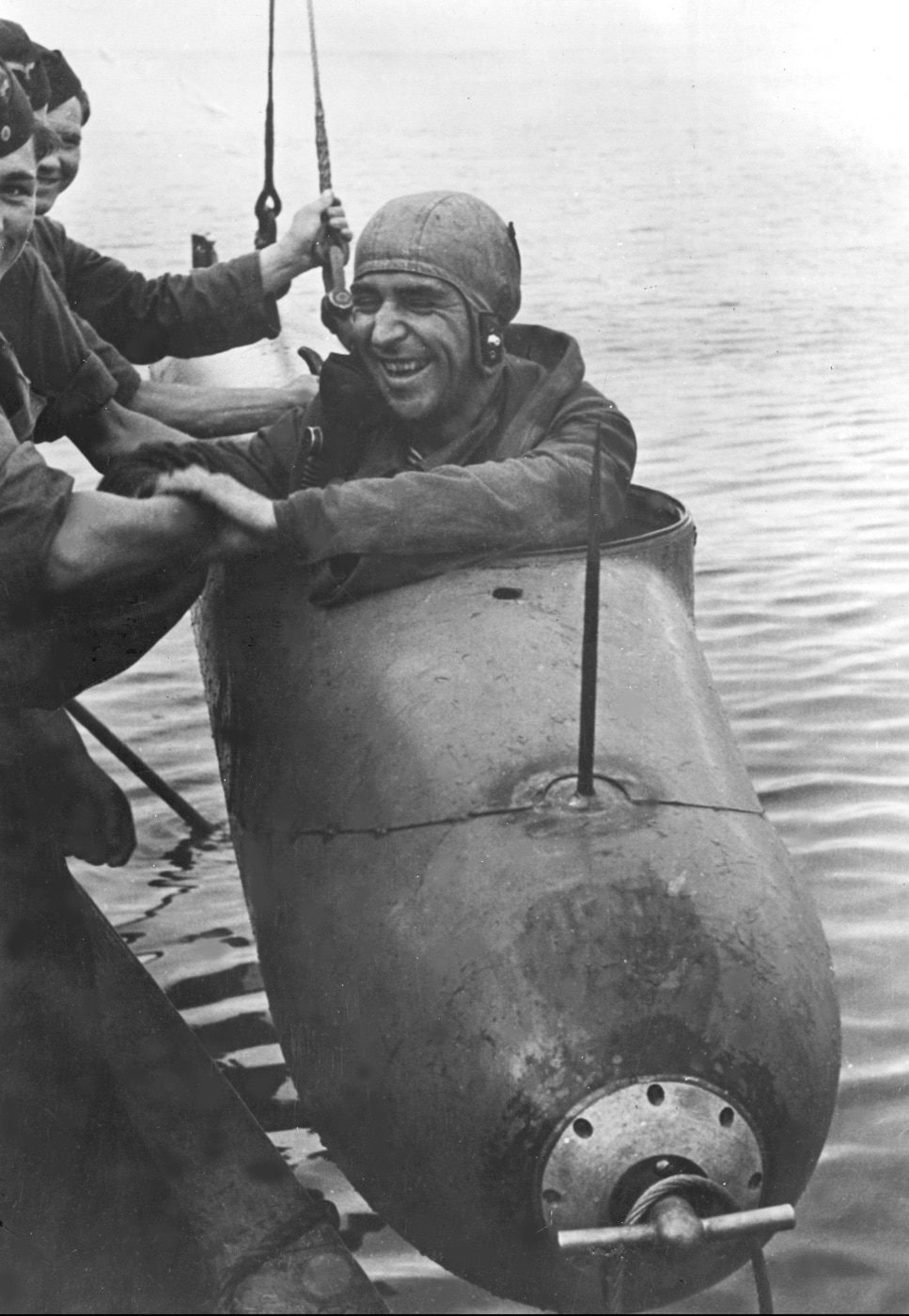
The cockpit was extremely tight and uncomfortable, and the operator sat awash in the water with his sightline only 18 inches above the surface. The plexiglass dome could be obscured by oil, seaweed, or debris, and could not be cleaned while in action. If the dome was opened while at sea, the craft was easily swamped — and in the earliest models the dome could not even be opened from the inside! Some losses were incurred from carbon monoxide poisoning.
Targeting the torpedo was crude, with an “aiming spike” installed at the front end of the Marder control torpedo — used in conjunction with a graduated scale embedded within the canopy. Inside the cockpit, a lever released the G7e torpedo, which ran at a preset depth.
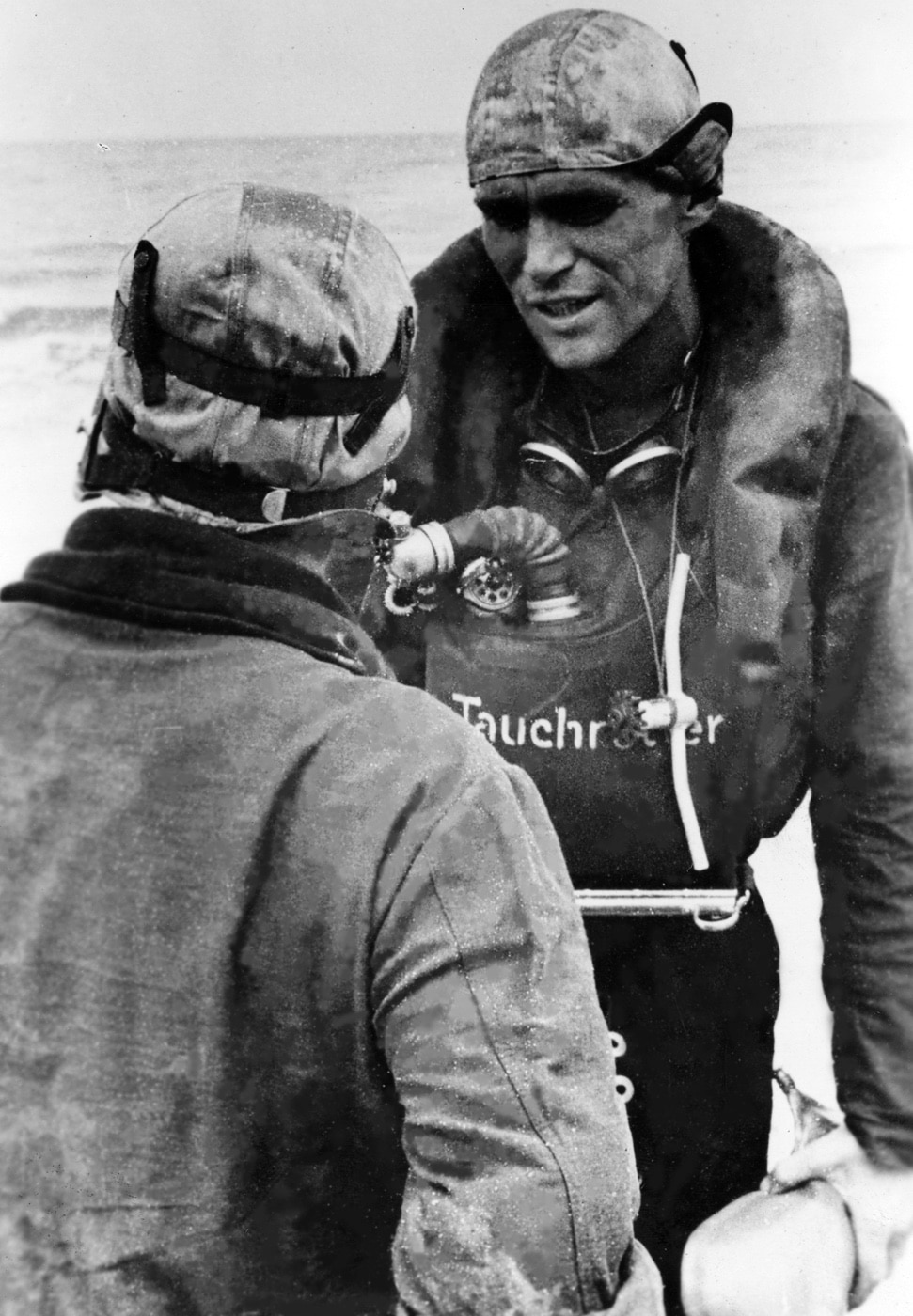
A major design flaw in the weapon system could turn it, quite literally, into a “human torpedo”: When the G7e’s electric motor was started the operator released the weapon. However, the armed torpedo did not always separate from the carrier. In those cases, the torpedo quickly carried the entire combination and its pilot on a one-way journey to the target. The lucky ones missed.
Some naval historians have described the Marder as “marginally reliable” from a technical standpoint. Even so, the pilot was overwhelmed by the volume of tasks to operate the craft, from navigating to the operational area, performing a stealthy approach to the target, and then lining up and launching his torpedo against an ever-alert enemy.
The tremendous losses among the operators, about 70 percent overall, clearly demonstrates that the craft was as dangerous to its pilot as it was to the enemy. About half of all the losses of this system were due to accidents.
Quickly Into Service
The concept of the mini sub “small battle units” was a subject of some controversy in the German military. Admiral Dönitz, Grand Admiral of the Kriegsmarine, and architect of the elite U-Boat arm, saw little value in the manned torpedoes and forbade any recruiting of U-boat men to crew them. Consequently, the recruits were brought in from other areas of the Kriegsmarine, the Wehrmacht, and even a few from the Luftwaffe.
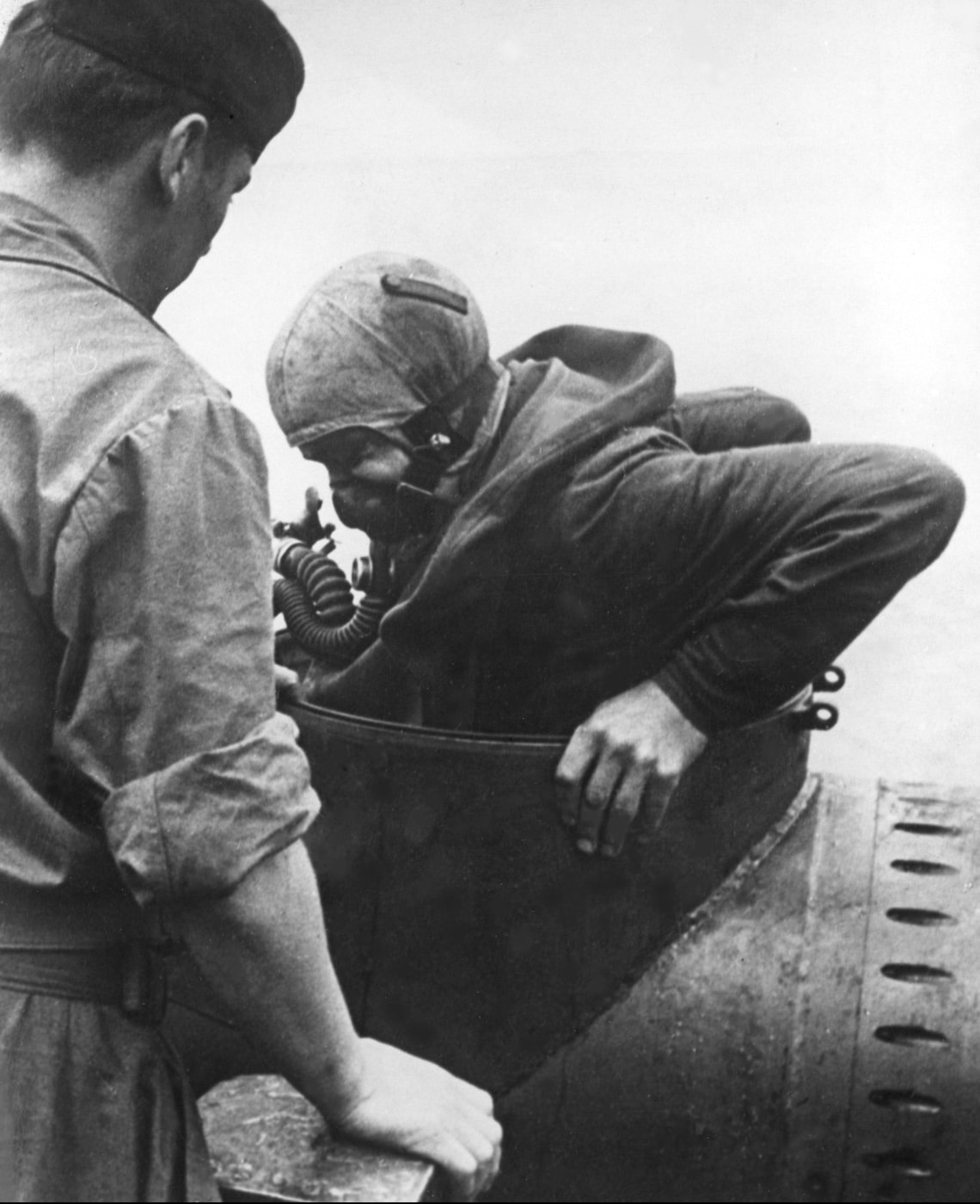
It seems that the torpedo “pilots” were given scant information about their mission to mask the nearly suicidal nature of the job. Meanwhile, Hitler was thrilled with the concept, and dreamed of tremendous success against Allied warships. It comes as little surprise that even before they were fully tested, the human torpedoes were sent into combat on April 20, 1944 — the Fuhrer’s birthday.
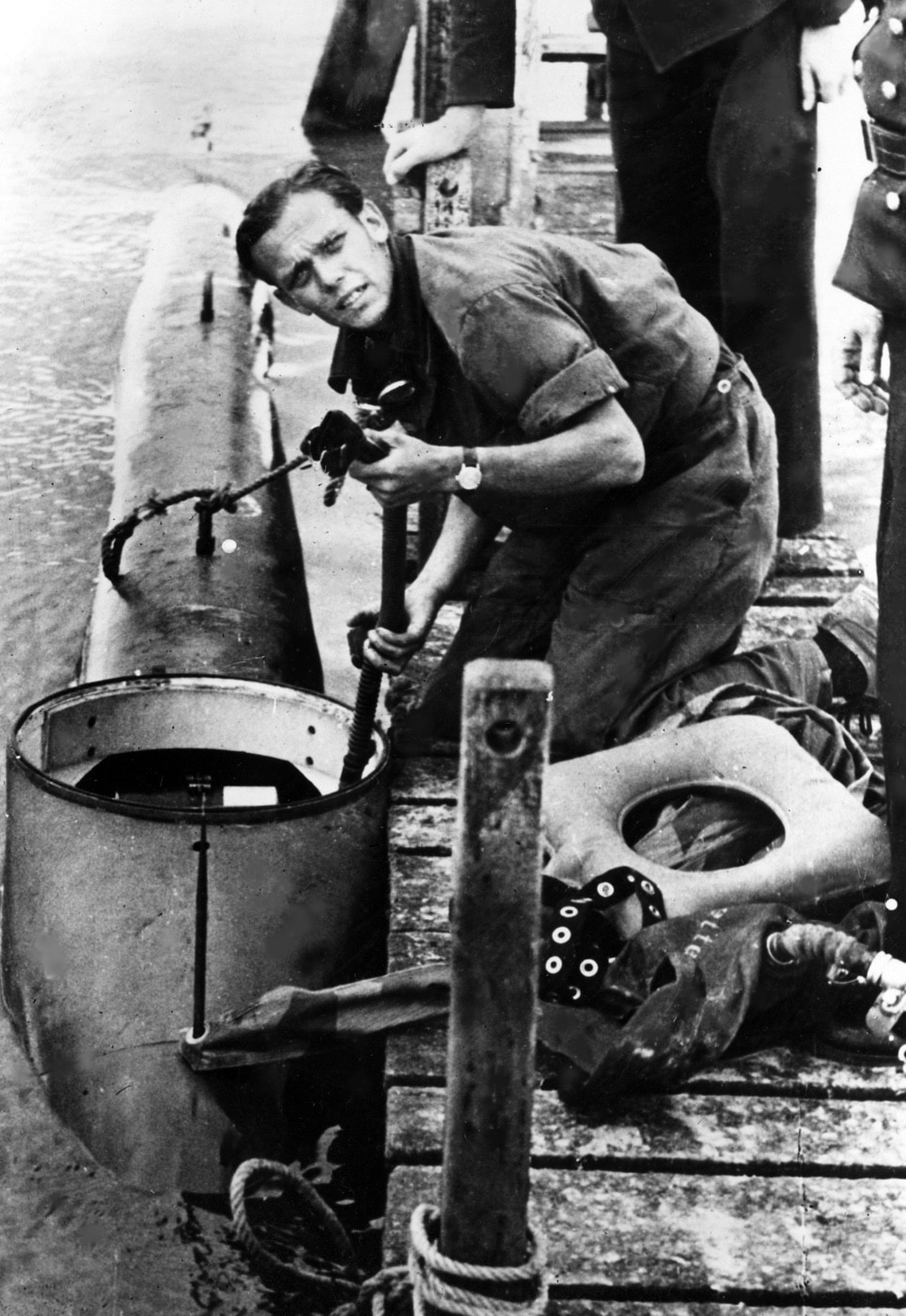
About 40 of the new special attack craft were sent to attack ships of the invasion force in the Anzio-Nettuno area. Allied patrol and escort ships discovered the manned torpedoes on the morning of April 21, claiming five destroyed by gunfire or depth charges. One of the torpedo pilots was captured. The following day, the Allies received a naval intelligence coup as one of the manned torpedoes washed ashore intact, its pilot killed by carbon-monoxide poisoning.
Normandy Invasion Fleet
In an effort to disrupt the massive invasion fleet gathered off the coast of Normandy, the Germans gathered their special attack force at Villers. On the night of July 5, 1944, they made their first attack against the far eastern elements of the “Trout Line” defense ring, with 26 of the manned torpedoes sortied.
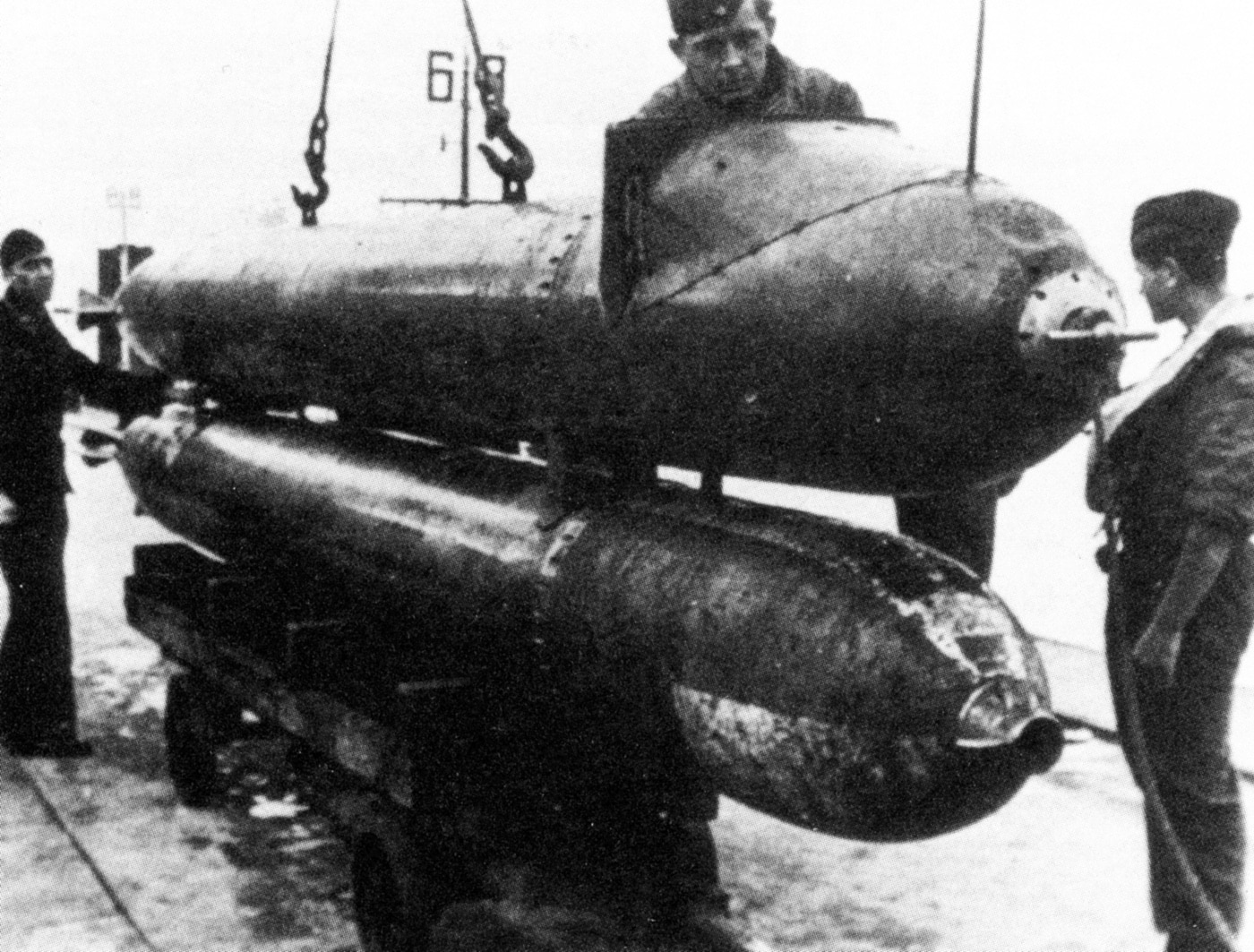
The light cruiser ORP Dragon (Free Polish Navy designation, formerly HMS Dragon) was hit and damaged beyond repair. It was scuttled on July 20, 1944. Three Royal Navy minesweepers were sunk. German losses were extremely high, as only five of the Marders returned.
A few more missions followed until the final sortie on August 15/16. The loss ratios were nearly suicidal, exceeding 60%. German successes were few, most notably the destroyer HMS Quorn sunk on August 3rd with a heavy loss of life. As we know, these attacks did not stop Operation Neptune.
U.S. Naval Intelligence Report
In response to the Allied landings in Southern France in August 1944, the Germans deployed a group of Marder manned torpedoes to engage the invasion fleet. Several unsuccessful attacks were launched in the Monte Carlo, Menton and San Remo areas.
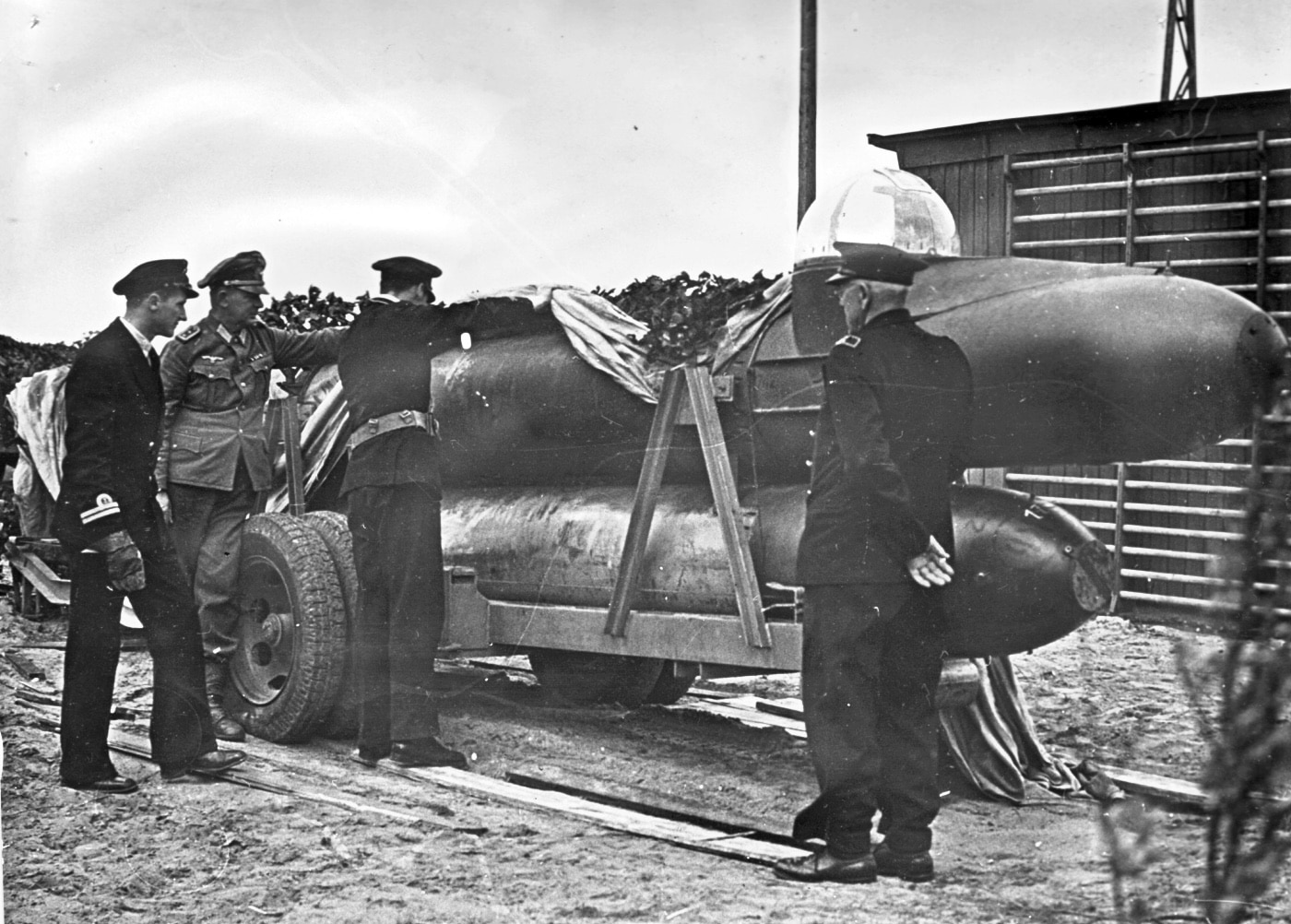
I found the following US Naval Intelligence report detailing the interviews with six captured Marder pilots. The statements of the manned torpedo pilots taken prisoner provide valuable insight into the uncertain capabilities of their weapon, their tactics, and the mindset of the men piloting Germany’s “small attack units”.
Preliminary Interrogation of six German POWs after human torpedo attack in Ventimiglia area, 10 September 1944. This group probably was intended for Normandy operations, for it started into France, but two weeks ago it was diverted to Italy by railroad.
-Typed cruising instructions found on POW Dresel indicates that human torpedoes operate in box formation. At eight knots this would take them sixteen miles to seaward, with a half hour rest period at seaward limit, and return them to their starting point. Their endurance was said to be 8-10 hours and maximum speed of 8-10 knots. Interrogation reveals that the human torpedoes were launched sometime between midnight and 0300. When discovered at 0718B they were all headed for shore which substantiates the belief that they were sent out on a night patrol mission. POWs said they were not given special targets such as battleships or cruisers. It is believed that the Germans anticipated a landing in the Cape Mortola area and that other groups may be encountered in likely assault areas from Ventimiglia eastward.
–Typed firing data instructions were found on POW Dresel indicating that human torpedoes approach targets on the bow if possible, and close to five to six hundred meters for a 90-degree attack angle. Lead angles for estimated speeds were given. POWs exhibited a healthy respect for PT Boats and it is believed that a coordinated plane and PT Boat patrol are the best defensive measures to be employed in sweeping destroyers and above from attack.
–POWs said that only two helpers are needed to launch the torpedoes which are removed from the truck, placed on wheels, and moved to a launching area. It is thought likely that they utilize solid footing as much as possible, such as ramps, docks, and surfaced roads. One prisoner said they could be launched on the sand but that he had never tried it.
–POW Benajmin Will was a 22-year-old “Obergefreiter” and prior to his service in the human torpedoes he was a trumpeter in a German Navy band for three years. He said the guided torpedoes were widely advertised in Germany by radio and otherwise as a new weapon, known to the Allies, and therefore could now be revealed. On that basis Will volunteered for service in this new type of submarine service in May (1944) and underwent training on the North Sea coast. During training, and since, the activity has been surrounded with close secrecy and the members have been made to feel they are a part of a new secret development. Prior to this, Will had no sea experience.
Will claims that his orders were very vague. He was told to see what he could find and if he found nothing to wait for his targets. He claims he could wait for a target, but it got boring; that his machine could not submerge. After five hours at sea, he developed trouble. His machine would go only in fits and starts so he headed for the beach and let his torpedo go so he could ride better with only his carrier.
–Endurance depends on the supply of oxygen. The speed of the unit together is faster than a man can run. Without the torpedo, after launching it, the machine is somewhat faster. Recovery plans are that, after launching the torpedo, the operator will head for the shore on his own. Machines are organized in groups of six to eight.
–Will seemed to not know too much about the mechanism — the fit is tight, and a small man can get along better than a large man, but there are no restrictions as to the size of the men in the service. Will was unable to tell what was wrong with his particular machine. It would run only in fits and starts. The operators had been taught to direct themselves by the stars for getting off the coast.
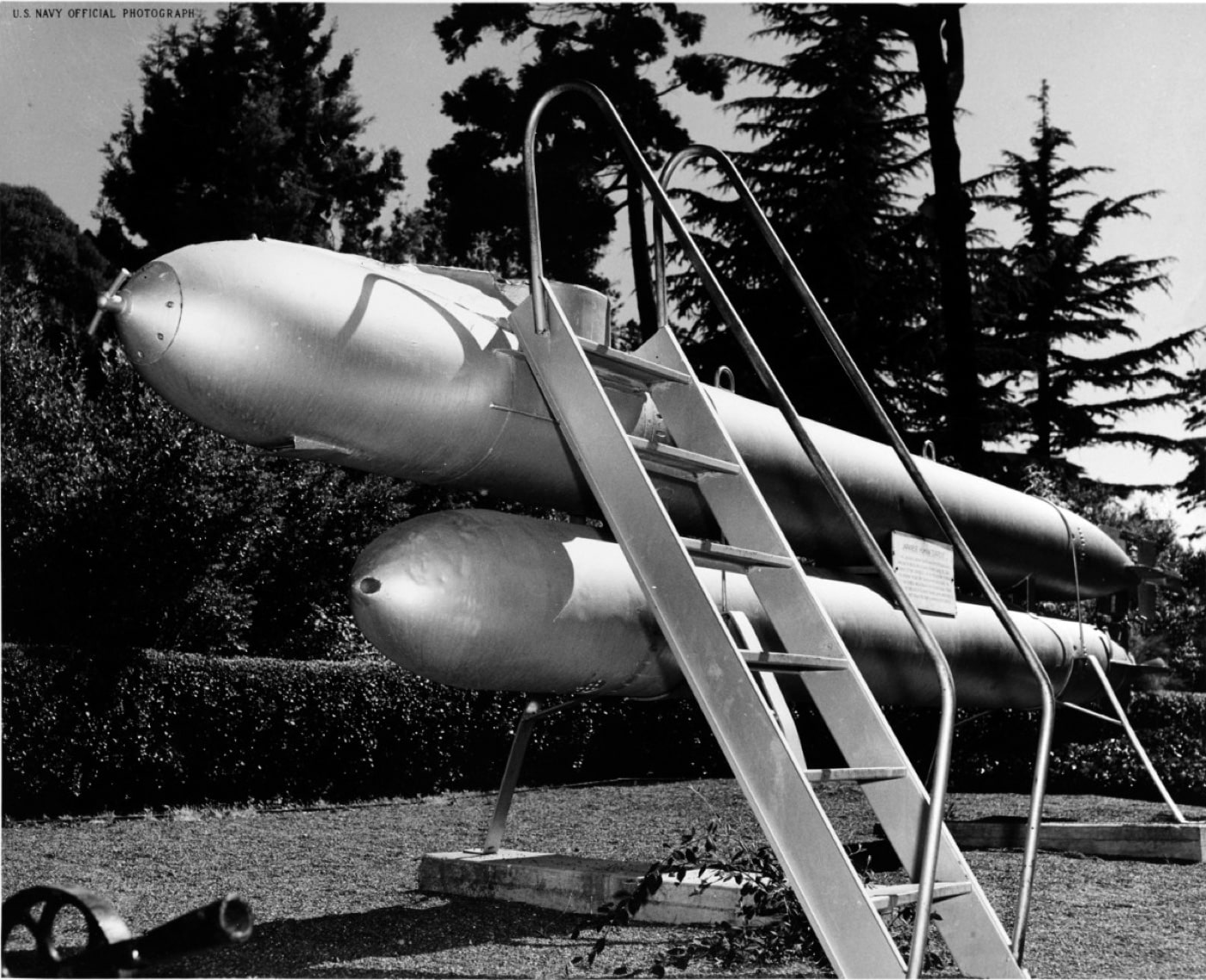
POW Horstmann described the use of the machine:
The weapon and the technique have not yet been perfected. It is, however, handy enough to control and resembles those of an airplane somewhat. There is a stick between the knees by which you steer right or left and up or down within limits. Power is electric. On the right side of the operator are two levers, one for starting and one for regulating the speed. On the left is a lever which releases the torpedo.”
POWs claimed that they desire to launch the torpedo from 500-600 meters from the target and usually seek to get a 90-degree angle. A moving target is very difficult for them to hit. POWs believed they could only hit one out of every ten moving targets they fired upon.
US Naval Intelligence made this assessment of the human torpedo operators they captured:
Inexperienced, ignorant young, enlisted men, ranging from 18 to 23 years of age, of the German Navy, who have volunteered for a widely advertised new service as “solo fighters”, in which they hope to gain promotion and honor. All rates, up to petty officer first class, are represented. They know little about what they are getting into.
Editor’s Note: Be sure to check out The Armory Life Forum, where you can comment about our daily articles, as well as just talk guns and gear. Click the “Go To Forum Thread” link below to jump in!
Join the Discussion
Continue Reading
Did you enjoy this article?

 366
366






